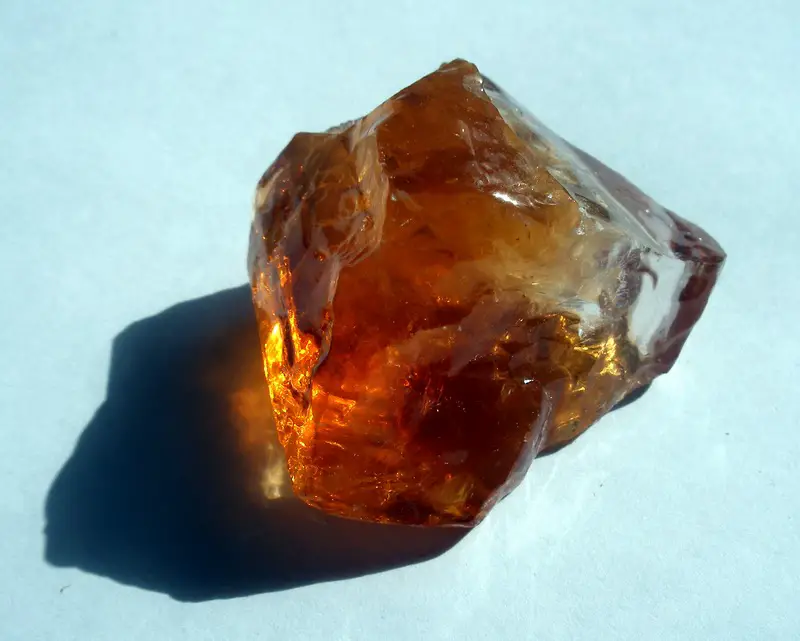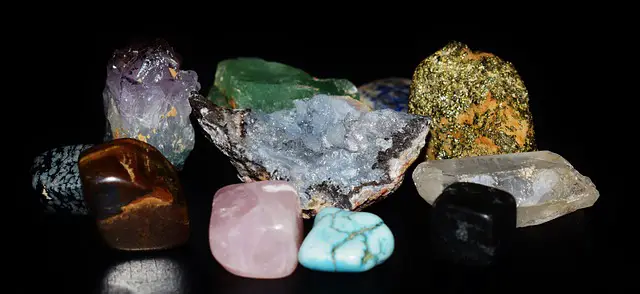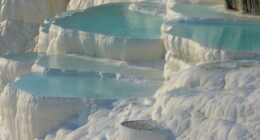Calcite is a soft mineral with a Mohs hardness of 3, while quartz is much harder with a Mohs hardness of 7. This means that calcite can be easily scratched by objects like fingernails or copper coins, whereas quartz cannot. Additionally, calcite often exhibits double refraction whereas quartz does not.
What is calcite?
(Photo By Anders Sandberg on Flickr)

Calcite is a mineral that can be found in various shapes, sizes, and colors. It is composed of calcium carbonate (CaCO3), which makes it one of the most abundant minerals on Earth. The chemical formula for calcite makes it a member of the carbonate group, in which other minerals such as aragonite and dolomite belong.
Calcite has several properties that make it unique among minerals. Its crystal system is trigonal, meaning its crystals have three axes with equal lengths and are at 120-degree angles from each other. Calcite also exhibits birefringence, or double refraction – when light passes through the crystal, it splits into two rays traveling at different speeds.
In terms of appearance, calcite can range from transparent to opaque and comes in a variety of colors including white, yellow-orange, red-brown, blue-green and gray-black. It often forms as rhombohedral-shaped crystals or scalenohedrons.
It’s worth noting that calcite has many uses beyond being just another pretty mineral. It’s used in construction materials such as cement and concrete due to its ability to act as a filler material while also improving their strength and durability. Additionally, it’s used in fertilizers for plants due to its high concentration of calcium ions essential for growth.
Calcite may seem like just another rock but with so many fascinating characteristics there’s no doubt this mineral will continue to capture our interest!
What is quartz?
(Photo By James Petts on Flickr)

Quartz is a mineral composed of silicon and oxygen atoms in a continuous framework of SiO4 silicon–oxygen tetrahedra, with each oxygen being shared between two tetrahedra, giving an overall chemical formula of SiO2. It’s one of the most abundant minerals found on Earth, making up around 12% by volume of the Earth’s crust.
Quartz can appear in different forms including colorless to smoky or black crystals, hexagonal prisms with pointed ends (known as “rock crystal”), purple or yellow crystals (amethyst), pink crystals (rose quartz) and yellow-brown or brownish-red crystals (citrine). In addition to its aesthetic appeal, Quartz has many practical uses due to its hardness and durability.
Because it’s exceptionally hard – rating at 7 on Mohs scale – it’s used for abrasive purposes such as sandblasting and cutting tools. Additionally, due to its piezoelectric properties which allow it to transform electrical energy into mechanical energy vice versa, Quartz is widely used in electronic devices such as watches and radios.
Calcite Vs. Quartz – Key differences
Calcite and quartz are two minerals that often get confused with each other. However, there are some key differences between the two that can help you distinguish one from the other.
Firstly, calcite is a carbonate mineral that is made up of calcium, carbon, and oxygen. It typically has a white color but can also be found in shades of green, blue, yellow or pink depending on impurities present during its formation. Quartz, on the other hand, is a silicate mineral composed of silicon and oxygen atoms. Its most common form is clear or milky white but it can also appear in colors ranging from pink to brown.
One major difference between calcite and quartz lies in their hardness level. Calcite ranks at three on Mohs hardness scale out of 10 while quartz ranks at seven making it much harder than calcite. This means that quartz will scratch calcite easily but not vice versa.
Another difference between these two minerals lies in their crystal shapes. While both have hexagonal crystals when viewed under a microscope, they differ greatly in terms of cleavage (how they break). Calcite has perfect rhombohedral cleavage meaning it breaks along flat faces creating an angled shape whereas Quartz has no preferred direction for breaking so it fractures randomly.
Understanding the key differences between these two minerals will help you differentiate them effectively as well as appreciate their individual properties and uses more accurately.
How to identify calcite ?
To identify calcite, there are a few key characteristics to look for. Firstly, calcite is typically transparent or translucent and has a vitreous luster. It can also be found in a variety of colors such as white, grey, yellow, green and red.
When it comes to identifying calcite by its physical properties, one way is to test its hardness using the Mohs scale. Calcite has a relatively low hardness of 3 on this scale and can be easily scratched with a knife or fingernail. Additionally, calcite exhibits double refraction which means that light passing through it will create two images instead of one.
Another common way to identify calcite is through acid testing. When exposed to weak hydrochloric acid (such as vinegar), calcite will fizz and dissolve due to its high reactivity with acids.
It’s important to note that some minerals may share similar characteristics with calcite so proper identification techniques should always be used before assuming any mineral specimen is actually composed of pure calcium carbonate (calcite).
How to identify quartz?
Quartz is a mineral that can be identified by its unique physical and chemical properties. One of the most distinctive features of quartz is its hardness, which makes it difficult to scratch. So if you have a mineral specimen that cannot be scratched with a knife or nail, chances are high that it’s quartz.
Another way to identify quartz is by examining its color and transparency. Quartz comes in various colors like white, yellow, pink, purple, gray and black. It can also exhibit different levels of transparency – from transparent to opaque.
Additionally, the crystal structure of quartz can help identify the mineral. Quartz crystals often have six-sided prisms with pointed ends forming a hexagonal shape when viewed from above.
If you’re still unsure whether your specimen is quartz or not, try performing some simple tests such as rubbing it against glass or observing how light reflects off its surface. If it leaves no scratch marks on glass and refracts light in a specific pattern called birefringence then there’s a good chance it’s quartz.
Identifying quartz requires careful observation and analysis of its physical and chemical properties along with conducting simple tests at home using readily available items like glass plates or UV lights for fluorescence testing.
Uses for calcite and quartz
Calcite and Quartz are both minerals with various uses in different fields. Calcite is commonly used for manufacturing cement, as a soil conditioner, and as a flux in the production of iron and steel. It is also used to make antacids because it can neutralize stomach acid.
On the other hand, quartz has numerous industrial applications due to its unique physical properties such as hardness, clarity, and resistance to heat. One of its most popular uses is in the manufacturing of glass products like lenses for eyeglasses, windows for buildings, and screens for electronic devices.
Quartz is also widely used in electronics since it can conduct electricity under certain conditions making it an essential component in many electronic devices including smartphones.
In addition to these industrial applications, both calcite and quartz have metaphysical properties that make them popular among people who believe in alternative healing methods like crystal therapy or chakra balancing.
Calcite and quartz have different but equally important uses depending on their unique characteristics which makes them valuable resources across multiple industries.
Can quartz scratch glass?
Quartz is a hard mineral that scores 7 on the Mohs hardness scale, just below diamond. This makes it one of the hardest minerals in nature and highly valued for its durability. But can quartz scratch glass?
The answer is yes, quartz can scratch glass. While glass has a hardness rating of about 5.5 on the Mohs scale, making it relatively soft compared to quartz, it can still be scratched by harder minerals like quartz.
However, not all types of glass are created equal. Some types of tempered or laminated glasses may be more resistant to scratching than regular soda-lime glass due to their manufacturing processes and additional layers.
It’s also worth noting that while quartz can potentially scratch glass, it doesn’t necessarily mean that every piece of quartz will have sharp edges capable of causing damage. In fact, many pieces of polished or tumbled quartz are smoothed out and won’t cause any harm to your average piece of glassware.
While it’s technically possible for quartz to scratch glass under certain conditions, it’s not something you need to worry about in most situations if you’re handling polished pieces or common household items made from both materials (like windows).
Featured Image By – Brett Hondow from Pixabay








